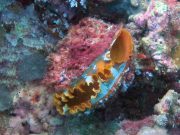Diving with Spiny Oysters
Lanta Marine Life | Spondylidae
Spiny or thorny oysters can be easily spotted at nearly all of the sites during our high season Koh Lanta dive trips.
The many species vary considerably in appearance and are actually related to scallops, rather than oysters. Similar to oysters however, they live cemented to rocks, corals or other hard surfaces and are capable of producing pearls, depending on their environment.
This family has a very well developed middle mantle and nervous system, with sensory tentacles and multiple eyes around the shell edges. Spiny oysters have a ball and socket type connection between the two shell parts, rather than the more common toothed hinge of other bivalves.
Spiny oysters are filter feeders and can suck water into its gills to remove oxygen and food.
1 species found on this page:
Variable Thorny Oyster
(Spondylus varians)

Spondylus varians @ Koh Haa
The variable thorny oyster Sphondylus varius is the largest of the spiny oysters, growing to a maximum diameter of around 20 cm.
The shell is of this species can be easily recognised because the main adult shell is white, with the bright red or yellow larval shell remaining at the joint end of the shell (the connection between the two sides). The larval shell is however difficult to see as the main shell is usually overgrown with algae and other life.
Diving with Spiny Oysters around Koh Lanta
Scuba Diving & Snorkel Trips
If you'd love a chance to spot Spiny Oysters on one of our daily high season diving trips from Koh Lanta then send us an email to info@diveandrelax.com.
Join our high season speedboat dive trips to some of Thailand's best dive sites and enjoy small groups, short journey times, with a focus on great personal service, safety and fun.
Not yet a certified diver? Learn to Scuba Dive on Koh Lanta with the 3 day SSI Open Water Diver course.
Book online to save 10% on dive trips and scuba courses on Koh Lanta.
Find Out More
Indo-Pacific Marine Life Guides
- Allen, G., Steene, R., Humann, P., DeLoach, N. (2003) Reef Fish Identification, Tropical Pacific. Jacksonville, FL., USA: New World Publications, Inc., ISBN 1-878348-36-1.
- Humann, P., DeLoach, N., (2010) Reef Creature Identification, Tropical Pacific. Jacksonville, FL., USA: New World Publications Inc., ISBN 978-1-878348-44-9
- Debelius, H. (2013) Indian Ocean Reef Guide. Frankfurt, Germany: IKAN - Unterwasserarchiv, ISBN 978-3-939767-52-7.
- Debelius, H. (2004) Nudibranchs and Sea Snails, Indo-Pacific Field Guide. Frankfurt, Germany: IKAN - Unterwasserarchiv, ISBN 3-925919-51-1
- Erhardt, H., Knop, D. (2015) Corals Indo-Pacific Field Guide. Frankfurt, Germany: IKAN - Unterwasserarchiv, ISBN 3-925919-69-4.
- Veron J.E.N., Stafford-Smith M.G., Turak E. and DeVantier L.M. (2016). Corals of the World
